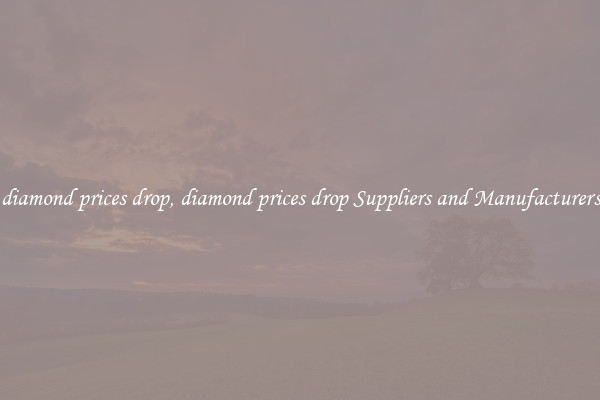diamond prices drop, diamond prices drop Suppliers and Manufacturers
Diamond Prices Drop: A Boon for Consumers, a Challenge for Suppliers and Manufacturers

In recent months, the diamond industry has witnessed a significant drop in prices. While this may bring a sense of excitement and delight for consumers looking to splurge on high-quality gemstones, it poses a challenging situation for suppliers and manufacturers.
The plummeting diamond prices can be attributed to several factors. Firstly, the global economic slowdown due to the COVID-19 pandemic has dampened the demand for luxury goods, including diamonds. With many people facing financial insecurity, purchasing expensive jewelry has become less of a priority.
Additionally, the rise of lab-grown diamonds has disrupted the natural diamond market. As technology advances, lab-grown diamonds have become increasingly popular due to their lower cost and ethical advantages. With consumers becoming more conscious of sustainability and environmental impact, the demand for lab-grown diamonds has surged, consequently driving down prices for natural diamonds.
While the drop in diamond prices may be perceived as advantageous for consumers, it poses a significant challenge for suppliers and manufacturers. With lower prices, profit margins are squeezed, making it increasingly difficult for businesses to maintain their operations.
Suppliers now face the dilemma of deciding whether to reduce their prices to stay competitive or hold on to their inventory in the hope that prices will rise again. Such predicaments can strain their cash flow and overall profitability, especially for smaller players in the market who do not have the financial cushion to weather prolonged periods of low prices.
For manufacturers, the decreasing diamond prices can lead to idle production lines and reduced activities. As demand dwindles, companies may face excess inventory, which can be detrimental to their financial health. They may need to consider scaling down operations or finding alternative revenue streams to offset the impact of the price drop.
However, this challenging situation also presents an opportunity for suppliers and manufacturers to innovate and adapt to the changing market dynamics. They can explore new marketing strategies, such as promoting the unique value of natural diamonds compared to their lab-grown counterparts. Emphasizing their rarity, durability, and timeless appeal may attract consumers who value the authenticity and symbolism associated with natural diamonds.
Moreover, this price drop can also encourage greater collaboration within the diamond industry. Suppliers and manufacturers can work together to streamline supply chains, reduce costs, and ensure sustainability. By fostering a sense of collective responsibility, the industry can collectively address the challenges posed by the price drop and build a stronger foundation for the future.
In conclusion, the diamond industry currently faces the repercussions of a significant drop in prices. While this may be a boon for consumers, it poses challenges for suppliers and manufacturers who must navigate through tough market conditions. However, with innovation, collaboration, and strategic adaptations, the industry can weather the storm and emerge stronger, ensuring the timeless beauty and allure of diamonds endures even in the face of changing trends and economic uncertainties.

View details

View details

View details

View details








